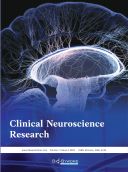Analysis of the Efficacy of Neuroendoscopic Hematoma Evacuation in the Treatment of Chronic Subdural Hematoma and its Influence on the Neurological Function of Patients
Abstract
Objective: To analyze the effect of neuroendoscopic hematoma evacuation on neurological function in patients with chronic subdural hematoma (CSDH). Methods: From September 2019 to September 2022, 113 patients with CSDH were selected and randomly divided into group A for neuroendoscopic hematoma evacuation and group B for soft channel drainage. The differences in neurological function of these two groups were compared. Results: Except for intraoperative blood loss and duration of surgery, all surgical indicators in group A were better than those in group B , P < 0.05. One month after operation, the neurological deficit (CSS) score in group A was lower than that in group B, and the quality of life (SF-36), activities of daily living (ADL) scores were higher than those in group B, with P < 0.05. 7 days after operation, the scores of superoxide dismutase (SOD), malondialdehyde (MDA), glutathione peroxidase (GSH-Px) and other oxidative stress indicators were better than those in group B, P < 0.05; the complication rate in group A was lower than that in group B, with P < 0.05. Conclusion: Neuroendoscopic hematoma evacuation therapy can regulate oxidative stress indicators, improve nerve defects, and improve the outcome of CSDH patients.
References
Qi W, 2021, Clinical Efficacy of Neuroendoscopic Hematoma Evacuation in the Treatment of Chronic Subdural Hematoma and its Impact on Patients’ Neurological Function. Journal of Mathematics and Medicine, 34(10): 1468–1470.
Chen S, Cheng H, Xu C, et al., 2022, Comparative Analysis of Efficacy and Safety of Chronic Subdural Hematoma Treated by Neuroendoscopy or Drilling Drainage. Chinese Journal of Practical Nervous Diseases, 25(10): 1221–1225.
Fang F, Liang R, Xu W, 2022, Effect and Prognosis Analysis of Neuroendoscope-Assisted Surgery in the Treatment of Septal Chronic Subdural Hematoma. Chinese Medicine Innovation, 19(1): 154–157.
Wang J, Wang Z, 2022, Comparison of Curative Effect of Neuroendoscopy and Hard Channel Drainage in Elderly Patients with Chronic Subdural Hematoma. Zhejiang Trauma Surgery, 27(1): 123–124.
Wang C, Yu J, 2022, Neuroendoscopic Surgery for 32 Cases of Segmented Chronic Subdural Hematoma. Chinese Journal of Clinical Neurosurgery, 27(8): 686–687.
Deng W, Wang C, Qian Z, et al., 2021, Efficacy of Soft Channel Drainage and Neuroendoscopic Hematoma Evacuation in the Treatment of Chronic Subdural Hematoma and its Effect on Oxidative Stress. Journal of Guangxi Medical University, 38(4): 806–811.
Chen L, Huang S, Zhang L, et al., 2021, Efficacy of Neuroendoscopic Hematoma Evacuation and Traditional Drilling and Drainage in the Treatment of Patients with Chronic Subdural Hematoma. Medical Equipment, 34(3): 112–114.
Deng G, Guan B, Zeng M, et al., 2021, Clinical Effect of Neuroendoscopic Hematoma Evacuation in the Treatment of Septal Chronic Subdural Hematoma. Chinese Medicine Science, 11(14): 181–184.
Gao K, Yao Y, 2021, Efficacy of Neuroendoscopic Hematoma Evacuation and Traditional Drilling and Drainage in the Treatment of Patients with Chronic Subdural Hematoma. Chinese Science and Technology Journal Database (Full Text Version) Medicine and Health, 6(8): 128–129.
Ma Y, Zhou Y, Liu L, et al., 2020, Comparison of the Therapeutic Effects of Neuroendoscopic Hematoma Evacuation and Soft Channel Drainage on Chronic Subdural Hematoma. Chinese Science and Technology Journal Database (Full Text Version) Medicine and Health, 7(12): 216–217.

